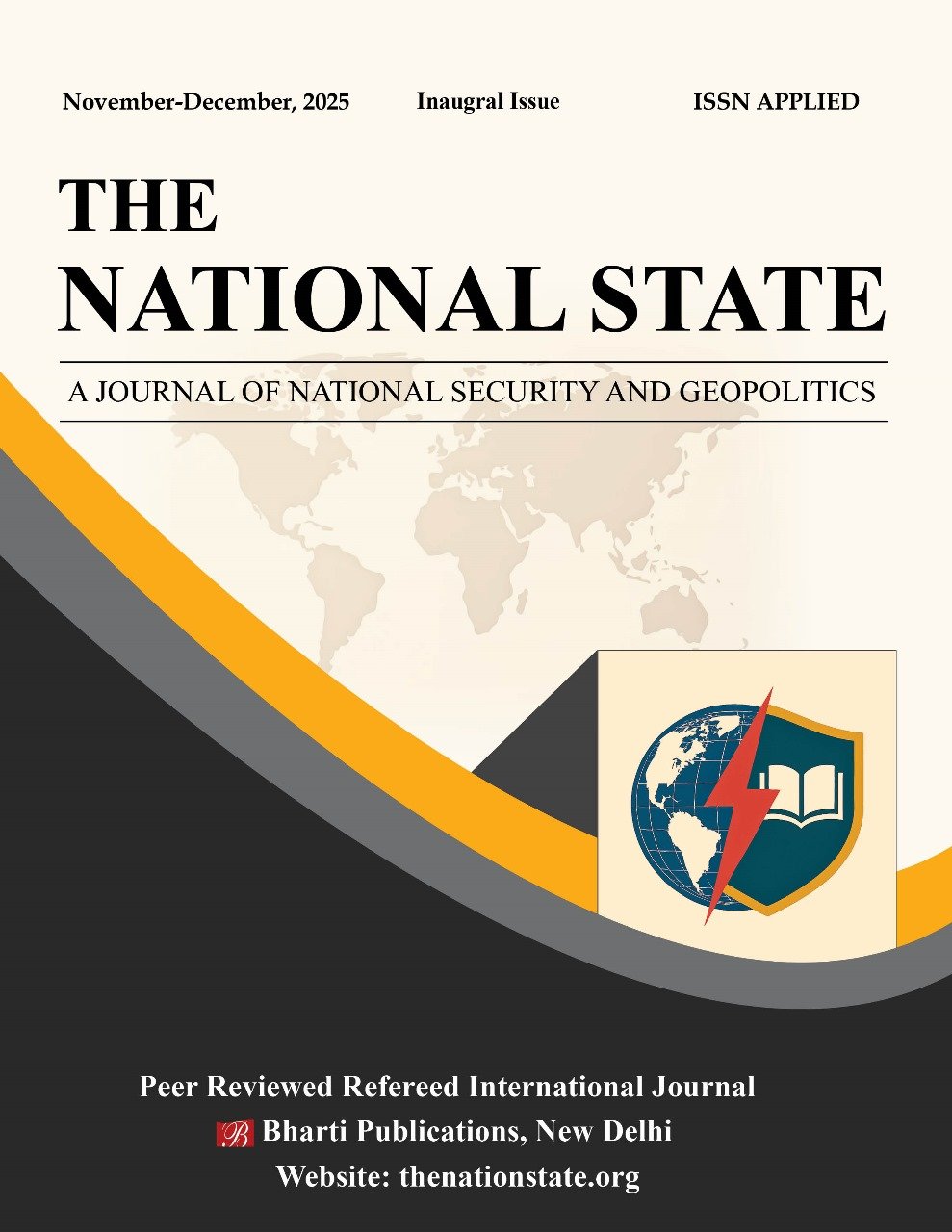Cultural diplomacy: Soft Power Strategy of India and South Korea
Main Article Content
Abstract
India and South Korea enjoy a connection nowadays which has been formed through both strategic and historical components. The connection goes beyond official diplomacy. Buddhism has come to Korea via India centuries back, developing strong ethical and cultural links. The feeling of trust that lives on today was built with these fundamental values.
Each nation restored these cultural ties in the past several decades to offer help in modern-day relations. Cultural diplomacy has become known as a essential weapon for encouraging unity as well as confidence. This research addresses why culture helps long term goals though Melissen’s new public diplomacy framework and Joseph Nye’s theory of soft power. This highlights how India and South Korea benefit from cultural ideational to strengthen their bond .
The shift is made clear due to real-world scenarios. Educational collaborations, joint creativity programs and youth- related activities are managed though The Indian Council for Cultural Relations (ICCR) and The Korean Cultural Centre (KCC). These type of activities have an impact of connecting people closer and creating greater understanding. Due to friendly good will , bilateral trade among India and South Korea hit over USD 27 billion in 2023. Under partnerships such as the 2010 Comprehensive Economic Partnership and the 2019 logistics pacts for naval cooperation, these two nations are also working together in science, technology and defence.
The involvement of the public has increased because of interaction with culture on internet and online platforms. Indian yoga celebration in Seoul and Busan, K-pop and Korean films indicate how true diplomatic achievement could come from common cultural connection. Ongoing interactions increase confidence, which helps Indo-Pacific security and economic goals. In line with the study, culture as well as strategy were complimentary. Loyalty, respect, affection and common beliefs or ideals are the basic principles of successful interaction between nations. Cultural diplomacy is an effective tools for peace and development like shown by India and South Korea. Towards those countries who want powerful people-centerd interaction in Indo-Pacific area, their alliance can serve as a case in point.
Article Details
Section

This work is licensed under a Creative Commons Attribution 4.0 International License.
All authors publishing in The Nation State: Journal of National Security and Geopolitics retain copyright to their work without restriction and grant the journal the right of first publication. Articles are simultaneously distributed under the terms of the Creative Commons Attribution-ShareAlike 4.0 International (CC BY-SA 4.0) license.
Under CC BY-SA 4.0, you are free to:
- Share – copy and redistribute the material in any medium or format
- Adapt – remix, transform, and build upon the material for any purpose, even commercially
provided that you comply with the following terms:
- Attribution – you must give appropriate credit, provide a link to the license, and indicate if changes were made. You may do so in any reasonable manner, but not in any way that suggests the licensor endorses you or your use.
- ShareAlike – if you remix, transform, or build upon the material, you must distribute your contributions under the same license as the original.
- No additional restrictions – you may not apply legal terms or technological measures that legally restrict others from doing anything the license permits.
Authors remain free to enter into additional non-exclusive agreements for distribution (e.g., posting to institutional repositories or websites), provided that such agreements acknowledge initial publication in The Nation State: Journal of National Security and Geopolitics and maintain the CC BY-SA 4.0 license on the journal’s version of record.
For full license details, please visit https://creativecommons.org/licenses/by-sa/4.0/.
How to Cite
References
1. Desai, P. N. (2023). Resurgence of India’s soft power diplomacy. ResearchGate.https://www.researchgate.net/publication/384233113_Resurgence_of_India's_soft_power_diplomacy
2. Ministry of External Affairs (MEA). (2023). India–Republic of Korea Bilateral Relations. Government of India.https://www.mea.gov.in/portal/foreignrelation/india-rok_bilateral_relations__1_.pdf
3. Ministry of External Affairs (MEA). (2024, July). India–Republic of Korea Bilateral Relations. Government of India.https://www.mea.gov.in/Portal/ForeignRelation/India-ROK_Bilateral_relations_July_2024.pdf
4. Nye, J. S. (2004). Soft power: The means to success in world politics. PublicAffairs.
5. Observer Research Foundation (ORF). (2023). India–Korea relations in the emerging dynamics of the Indo-Pacific (Special Report No. 211).https://www.researchgate.net/publication/372447420_India-Korea_Relations_in_the_Emerging_Dynamics_of_the_Indo-Pacific
6. Temple Diplomacy and India’s Soft Power. (2022). A cultural approach to foreign policy. SciSpace.https://scispace.com/papers/temple-diplomacy-and-indias-soft-power-a-cultural-approach-10bhxffy
7. The Korean Wave as the Globalization of South Korean Culture. (2022). SciSpace.https://scispace.com/papers/the-korean-wave-as-the-globalization-of-south-korean-culture-l3ktvg5x
8. Times of India. (2023, October 14). Fest marks 50th year of Indo-Korean ties.https://timesofindia.indiatimes.com/city/bengaluru/fest-marks-50th-year-of-indo-korean-ties/articleshow/104453227.cms
9. UNESCO. (2021). UNESCO science report: The race against time for smarter development. United Nations Educational, Scientific and Cultural Organization.https://digitallibrary.un.org/record/3945690/files/377433eng.pdf
10. Melissen, J. (Ed.). (2005). The new public diplomacy: Soft power in international relations. Palgrave Macmillan.https://culturaldiplomacy.org/academy/pdf/research/books/soft_power/The_New_Public_Diplomacy.pdf
11. Kim, S. (2021). Hallyu, public diplomacy, and development cooperation: Korea’s cultural diplomacy concocted for Africa. Journal of International and Area Studies, 28(2), 1–16.
12. Kesavan, K. V. (2020, February 14). India’s ‘Act East’ policy and regional cooperation. Observer Research Foundation.https://www.orfonline.org/expert-speak/indias-act-east-policy-and-regional-cooperation-61375/
13. Indian Council for Cultural Relations (ICCR). (2023). About ICCR. Ministry of External Affairs, Government of India.https://www.iccr.gov.in/
14. Korean Cultural Centre India (KCCI). (n.d.). About us.https://india.korean-culture.org/en
15. Indian Council of World Affairs (ICWA). (2025). Bilateral cooperation between India and South Korea.https://www.icwa.in/WriteReadData/RTF1984/9578539943.pdf
16. Basu, A. (2025, February 19). Facilitating “glocalism” between India and South Korea: A Pan-Asian perspective of culinary diplomacy. Nepal Institute for International Cooperation and Engagement (NIICE).https://niice.org.np/archives/9958
17. Carnegie Endowment for International Peace. (2021, October). South Korea beyond Northeast Asia: How Seoul is deepening ties with India and ASEAN.https://carnegieendowment.org/research/2021/10/south-korea-beyond-northeast-asia-how-seoul-is-deepening-ties-with-india-and-asean
18. Ahluwalia, P. S. (2025). Civic sense as a catalyst for national development: Cultivating responsible citizenship for a progressive nation. Siddhanta’s International Journal of Advanced Research in Arts & Humanities, 2(6), 166–185.https://doi.org/10.5281/zenodo.16023845
19. Kamraju, M. (2025). Civic sense in India: From indifference to involvement – A multidisciplinary study of behavior, governance, and youth engagement. Cultural Communication and Socialization Journal, 1(1), 25–36.https://www.researchgate.net/publication/393255132

